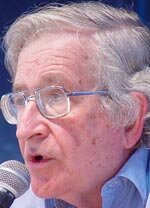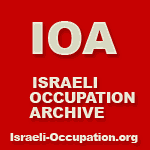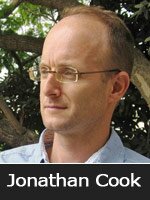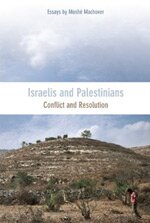By Lia Tarachansky, The Real News Network – 16 May 2011
http://therealnews.com/t2/index.php?option=com_content&task=view&id=31&Itemid=74&jumival=6781
West Bank and Gaza protests join historic day of demonstrations along Israel’s borders
On the 63rd commemoration of the Nakba (Arabic: Catastrophe), Palestinians coordinate a historic demonstration. Protests at the Lebanese, Syrian, West Bank, and Gazan borders and inside Egypt took place. Many died as a result of live fire, and hundreds were injured both from Israeli forces and others such as the Egyptian and Lebanese armies. The Real News’ Lia Tarachansky reports from the Qalandiya refugee camp in the West Bank where thousands demonstrated and summarizes the historic day in which refugees succeeded in breaking through the Syrian border and reuniting with Palestinians in the Golan Heights.
Transcript
LIA TARACHANSKY, TRNN: The Middle East saw unprecedented coordinated demonstrations on Sunday as Palestinians marked the 63rd Nakba Day. Protests took place at the Lebanese, Syrian, and West Bank borders with Israel, in Egypt, and in Gaza. They were met with live fire, leading to at least eight deaths and hundreds of injuries. But the demonstrations were a culmination of a weekend of resistance.
YOUNES ARAR, BEIT OMMAR POPULAR COMMITTEE: The Israeli Independence Day is our Nakba Day. And, unfortunately, our Nakba is ongoing since 1948 [incompr.] more colonization, more stealing of our land, more displacement.
TARACHANSKY: The West Bank’s weekly protests were met Friday with unusually severe violence from the Israeli army. Such protests are part of the ongoing Palestinian nonviolent campaign against the occupation and are typically interrupted by the Israeli forces. However, as the Israeli media presented the demonstrations as a potential third intifada, soldiers reacted with extreme violence. In an Nabi Saleh for example, dozens were injured on Friday as soldiers attacked protesters with clubs and teargas canisters. In East Jerusalem, the army shut down the Palestinian neighborhoods of Ras al Amud, and Silwan, which have become the unrelenting target of settler campaigns in recent years. Milal Said, a 17-year-old Palestinian, was killed during the clashes with the army. On Saturday during his funeral, the army once again closed off many Palestinian East Jerusalem neighborhoods, and undercover plainclothes officers were seen arresting Palestinians throughout the city. These demonstrations were organized in anticipation of Sunday, an annual commemoration known as Nakba Day. It is meant to remember 15 May 1948, when the Jewish leadership declared statehood in the middle of the first Israeli-Arab war in the region. Before the Zionist project to settle Jews in the region, Palestinians made up the majority of the territory known historically as Palestine. However, when the UN decided to allocate more than half the territory to the European-Jewish minority in the partition plan, civil war broke out. Weakened by the brutal British suppression of the 1936, 1939 strikes, the Palestinians lost the war and two-thirds of the population were forced to flee to neighboring countries, to the West Bank, and to Gaza. Jewish forces proceeded to demolish more than 500 Palestinian towns and villages. After the first Israeli prime minister, David Ben-Gurion, declared statehood, neighboring countries which also contended for the land invaded. The day also marked the establishment of the Israeli army as an organized force. Since those events 63 years ago, the Palestinian refugees have not been allowed to return. Today their descendants number almost 5 million. In commemoration, Palestinians protest every year to reaffirm their right of return. This year, in an unprecedented coordination, refugees from throughout the region organized protest along the Lebanese, Syrian, Gazan, and West Bank borders with Israel. Many were killed as they were met with teargas, rubber bullets, and in many places, such as Gaza, live fire. Along the Lebanese border, thousands marched towards Israel. At the same time, Palestinian citizens of Israel marched from the other side towards Lebanon. On both sides, the Israeli and Lebanese forces prevented them from reaching the border, leading to four casualties.
UNIDENTIFIED: And we can hear the [incompr.] now as we are speaking [incompr.] and we’re talking about a very slow [incompr.] This is probably a kilometer–or even less–far from where we are. When this all happened, the protesters came back and the organizers canceled the event. Ambulances [incompr.]
TARACHANSKY: But Syrian protesters managed to cross the border and poured en masse into the Golan Heights village of Majdal Shams. For many, this was their first time since they, their parents or grandparents were expelled six decades earlier. The Israeli army opened fire on the demonstrators and killed four. In Israel, this incident was reported as targeted fire shot in self-defense. But when news of the killings spread, Israeli activists organized an impromptu demonstration in the heart of Tel Aviv.
CROWD (SUBTITLED TRANSL.): We will not kill nor die for Zionism. You can’t build democracy with the dead bodies of prisoners.
TARACHANSKY: In the West Bank, two major protests were organized at the border village of al Walajeh and in the refugee camp of Qalandia.
GHASSAN BANOURA, JOURNALIST, PNN: People marched to the location of their old village. When they arrived there, troops attacked them using teargas and batons, arresting four civilians, among them Dr. Mazen Qumsiyeh.
TARACHANSKY: In Kalandia, the Palestinian Medical Relief Society reported at least 37 serious injuries, with seven hospitalizations. After four hours of demonstrating, the army decided to disperse the crowd using live ammunition.
CROWD (SUBTITLED TRANSL.): To go to Jerusalem, we will be martyrs.
UNIDENTIFIED (SUBTITLED TRANSL.): The right of return includes reparations.
TARACHANSKY: For The Real News, I’m Lia Tarachansky in the Qalandia Refugee Camp.
End of Transcript
























